You have planned financially for your dive vacation. Isn’t it time to implement a health and fitness plan to ensure you feel your best and can make the most of your trip? Chronic back pain is a major health challenge that limits comfortable participation in many physical activities such as scuba diving. Prevention is generally much more practical and effective than treatment. Regular exercise is a great way to free yourself from lower-back pain. Getting into the habit of doing exercises such as the ones in this article is a great way to promote good spine health.
These stretches are frequently prescribed to people with lower-back pain for rehabilitation, but if you currently have lower-back pain, be sure to consult with your physician or physical therapist prior to doing these exercises.
Complete these stretches five to 10 times. You can (and should) perform these exercises daily.
One of the most important areas to stretch for prevention of lower-back pain is your hamstrings. Your hamstrings run down the backs of your legs from your sitting bones (ischium) to just below your knees, crossing both your hip and knee joints. Tight hamstrings place unnecessary pressure on your lower back, which can lead to pain and musculoskeletal imbalances.
Lying Hamstring Stretch
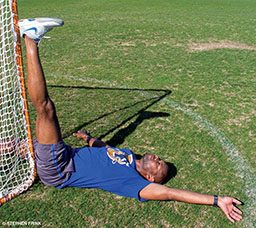
This stretch is done near a door or wall. The position places minimal stress on the lower back, allowing you to relax and move deeper into the stretch.
- Lie on your back with one leg near the vertical surface.
- Place the opposite leg on the floor.
- Work the first leg up the wall toward perpendicular, and hold for 20-30 seconds.
- Lower the raised leg back toward the starting position.
- Slide your butt closer to the wall, and repeat on the opposite side, holding for 20-30 seconds.
Tip: Remember to breathe while holding the stretch.
Scissor Hamstring Stretch
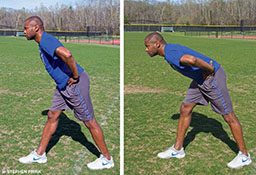
This stretch allows you to engage both hamstrings simultaneously.
- Step your right foot in front of your left, about a foot apart.
- Place your hands on your hips.
- Keep your hips and shoulders facing forward (the hip of the leading leg will move forward, make a conscious effort to bring it back).
- Keep your chest up and your head in a neutral position.
- Squeeze your shoulder blades together and down.
- Flex at your hips toward your front leg as far as you can without bending your knee.
- Hold for 20-30 seconds while breathing.
- Repeat on the opposite side.
Tip: Keep both legs straight, but be careful not to hyperextend your knees. You can avoid locking your knee by maintaining an imperceptible bend in your front knee.
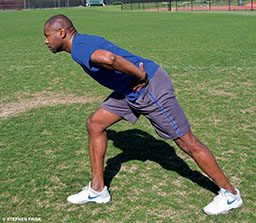
Bent-Knee Scissor Hamstring Stretch
You will feel this stretch higher in the hamstring of your front leg.
- Step your right foot further forward than in the last stretch.
- Place your hands on your hips.
- Bend your right knee.
- Make sure your weight is in your heel, not your toe.
- Keep your chest up and shoulder blades down and back.
- Flex forward, folding at your hips as far as you can.
- Hold for 20 seconds.
- Repeat on the opposite side.
Tip: Be sure to have your front foot far enough forward to keep your knee behind your toe. You can hold onto a secure surface such as a chair or wall for balance.
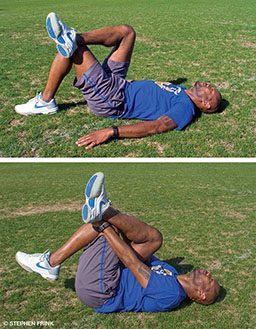
Piriformis Stretch
The piriformis muscle runs through the gluteal region. A tight piriformis can place pressure on the sciatic nerve, causing lower-back and leg pain. This stretch affects both the lower-back and piriformis muscles.
- Lie on your back with your knees bent.
- Place your right ankle on your left thigh.
- Pull your left knee toward your left shoulder.
- Hold for 20 seconds, and repeat on the opposite side.
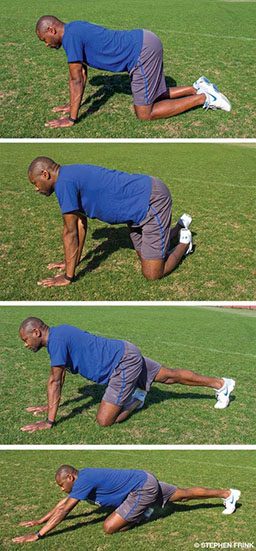
Tip: Make sure you are pulling your knee to your shoulder on the same side. Try to resist the tendency of the knee to drift toward center.
Deep Piriformis/Hip Stretch
- Start on your hands and knees with your hands under your shoulders and your knees under your hips.
- Keeping your knees in place, swing both ankles to the right.
- Extend your right leg and step it over your left.
- Move your hips backward, sliding your right foot back and bringing your right shoulder toward your left knee.
Tip: Try to keep your left foot from falling behind you.
Note: To avoid an increased risk of decompression sickness, DAN: recommends that divers avoid strenuous exercise for 24 hours after making a dive. During your annual physical exam or following any changes in your health status, consult your physician to ensure you have medical clearance to dive.
© Alert Diver — Q2 Spring 2016